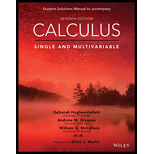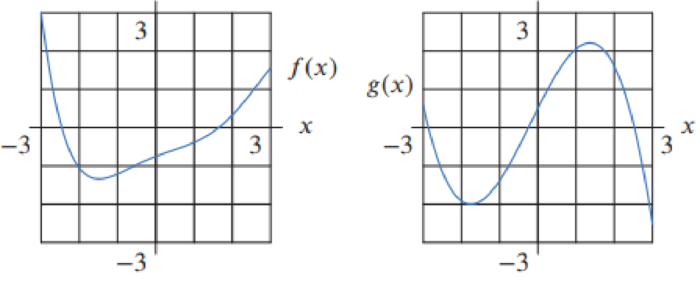Problem 1E: If f(x)=x2(x3+5), find f(x) two ways: by using the product rule and by multiplying out before taking... Problem 2E: If f(x)=2x3x, find f(x) two ways: by using the product rule and by using the fact that 2x3x = 6x. Do... Problem 3E: For Exercises 330, find the derivative. It may be to your advantage to simplify first. Assume that... Problem 4E: For Exercises 330, find the derivative. It may be to your advantage to simplify first. Assume that... Problem 5E: For Exercises 330, find the derivative. It may be to your advantage to simplify first. Assume that... Problem 6E: For Exercises 330, find the derivative. It may be to your advantage to simplify first. Assume that... Problem 7E: For Exercises 330, find the derivative. It may be to your advantage to simplify first. Assume that... Problem 8E: For Exercises 330, find the derivative. It may be to your advantage to simplify first. Assume that... Problem 9E: For Exercises 330, find the derivative. It may be to your advantage to simplify first. Assume that... Problem 10E: For Exercises 330, find the derivative. It may be to your advantage to simplify first. Assume that... Problem 11E: For Exercises 330, find the derivative. It may be to your advantage to simplify first. Assume that... Problem 12E: For Exercises 330, find the derivative. It may be to your advantage to simplify first. Assume that... Problem 13E: For Exercises 330, find the derivative. It may be to your advantage to simplify first. Assume that... Problem 14E: For Exercises 330, find the derivative. It may be to your advantage to simplify first. Assume that... Problem 15E: For Exercises 330, find the derivative. It may be to your advantage to simplify first. Assume that... Problem 16E: For Exercises 330, find the derivative. It may be to your advantage to simplify first. Assume that... Problem 17E: For Exercises 330, find the derivative. It may be to your advantage to simplify first. Assume that... Problem 18E: For Exercises 330, find the derivative. It may be to your advantage to simplify first. Assume that... Problem 19E: For Exercises 330, find the derivative. It may be to your advantage to simplify first. Assume that... Problem 20E: For Exercises 330, find the derivative. It may be to your advantage to simplify first. Assume that... Problem 21E: For Exercises 330, find the derivative. It may be to your advantage to simplify first. Assume that... Problem 22E: For Exercises 330, find the derivative. It may be to your advantage to simplify first. Assume that... Problem 23E: For Exercises 330, find the derivative. It may be to your advantage to simplify first. Assume that... Problem 24E: For Exercises 330, find the derivative. It may be to your advantage to simplify first. Assume that... Problem 25E: For Exercises 330, find the derivative. It may be to your advantage to simplify first. Assume that... Problem 26E: For Exercises 330, find the derivative. It may be to your advantage to simplify first. Assume that... Problem 27E: For Exercises 330, find the derivative. It may be to your advantage to simplify first. Assume that... Problem 28E: For Exercises 330, find the derivative. It may be to your advantage to simplify first. Assume that... Problem 29E: For Exercises 330, find the derivative. It may be to your advantage to simplify first. Assume that... Problem 30E: For Exercises 330, find the derivative. It may be to your advantage to simplify first. Assume that... Problem 31E: In Problems 3133, use Figure 3.14 and the product or quotient rule to estimate the derivative, or... Problem 32E: In Problems 3133, use Figure 3.14 and the product or quotient rule to estimate the derivative, or... Problem 33E: In Problems 3133, use Figure 3.14 and the product or quotient rule to estimate the derivative, or... Problem 34E: For Problems 3439, let h(x)=f(x)g(x), and k(x)=f(x)/g(x), and l(x)=g(x)/f(x). Use Figure 3.15 to... Problem 35E: For Problems 3439, let h(x)=f(x)g(x), and k(x)=f(x)/g(x), and l(x)=g(x)/f(x). Use Figure 3.15 to... Problem 36E: For Problems 3439, let h(x)=f(x)g(x), and k(x)=f(x)/g(x), and l(x)=g(x)/f(x). Use Figure 3.15 to... Problem 37E: For Problems 3439, let h(x)=f(x)g(x), and k(x)=f(x)/g(x), and l(x)=g(x)/f(x). Use Figure 3.15 to... Problem 38E: For Problems 3439, let h(x)=f(x)g(x), and k(x)=f(x)/g(x), and l(x)=g(x)/f(x). Use Figure 3.15 to... Problem 39E: For Problems 3439, let h(x)=f(x)g(x), and k(x)=f(x)/g(x), and l(x)=g(x)/f(x). Use Figure 3.15 to... Problem 40E: Differentiate f(t)=et by writing it as f(t)=1et. Problem 41E: Differentiate f(x)=e2x by writing it as f(x)=exex. Problem 42E: Differentiate f(x)=e3x by writing it as f(x)=exe2x and using the result of Problem 41. 41.... Problem 43E: For what intervals is f(x)=xex concave up? Problem 44E: For what intervals is g(x)=1x2+1 concave down? Problem 45E: Find the equation of the tangent line to the graph of f(x)=5xex at the point at which x = 0. Problem 46E: Find the equation of the tangent line to the graph of f(x)=x3ex at the point at which x = 2. Problem 47E: Find the equation of the tangent line to the graph of f(x)=2x5x+1 at the point at which x = 0. Problem 48E: In Problems 4851, the functions f(x), g(x), and h(x) are differentiable for all values of x. Find... Problem 49E: In Problems 4851, the functions f(x), g(x), and h(x) are differentiable for all values of x. Find... Problem 50E: In Problems 4851, the functions f(x), g(x), and h(x) are differentiable for all values of x. Find... Problem 51E: In Problems 4851, the functions f(x), g(x), and h(x) are differentiable for all values of x. Find... Problem 52E: The differentiable functions f and g have the values in the table. For each of the following... Problem 53E: If H (3) = 1, H (3) = 3, F(3) = 5, F (3) = 4, find: (a) G(3) if G(z)=F(z)H(z) (b) G(3) if... Problem 54E: Find the slope of the line tangent to h(x)=f(x)g(x) at x = 3, given that the line tangent to the... Problem 55E: Find a possible formula for a function y = f(x) such that f(x)=10x9ex+x10ex. Problem 56E: The density of veins on leaves tells us about a regions past climate. Scientists measure vein... Problem 57E: The quantity, q, of a skateboard sold depends on the selling price, p, in dollars, so we write q =... Problem 58E: A museum has decided to sell one of its paintings and to invest the proceeds. If the picture is sold... Problem 59E: Let f() be the gas consumption (in liters/km) of a car going at velocity v (in km/hr). In other... Problem 60E: The manager of a political campaign uses two functions to predict fund-raising: N(t) gives the... Problem 61E: A mutual fund holds N(t) million shares of a company with total value A(t) million dollars, where t... Problem 62E: A patients total cholesterol level, T (t), and good cholesterol level, G(t), at t weeks after... Problem 63E: For Problems 6366, use the graphs of h(x) and g(x) to find f(0) where f(x) = g(x)h(x). If this is... Problem 64E: For Problems 6366, use the graphs of h(x) and g(x) to find f(0) where f(x) = g(x)h(x). If this is... Problem 65E: For Problems 6366, use the graphs of h(x) and g(x) to find f(0) where f(x) = g(x)h(x). If this is... Problem 66E: For Problems 6366, use the graphs of h(x) and g(x) to find f(0) where f(x) = g(x)h(x). If this is... Problem 67E: In Problems 6769, explain what is wrong with the statement. The derivative of f(x)=x2ex is... Problem 68E: In Problems 6769, explain what is wrong with the statement. Differentiating f(x)=x/(x+1) by the... Problem 69E: In Problems 6769, explain what is wrong with the statement. The quotient f(x)=(x+1)/ex cannot be... Problem 70E: In Problems 7071, give an example of: A function involving a sine and an exponential that can be... Problem 71E: In Problems 7071, give an example of: A function f(x) that can be differentiated both using the... Problem 72E: Are the statements in Problems 7274 true or false? Give an explanation for your answer. Let f and g... Problem 73E: Are the statements in Problems 7274 true or false? Give an explanation for your answer. If the... Problem 74E: Are the statements in Problems 7274 true or false? Give an explanation for your answer. Suppose that... Problem 75E: Which of the following would be a counterexample to the product rule? (a) Two differentiable... Problem 76E: In Problems 7679, let f(x) = g(x)h(x), with g (2) = 0.5 and h (2) = 0.7. Either explain why the... Problem 77E: In Problems 7679, let f(x) = g(x)h(x), with g(2) = 0.5 and h(2) = 0.7. Either explain why the given... Problem 78E: In Problems 7679, let f(x) = g(x)h(x), with g (2) = 0.5 and h (2) = 0.7. Either explain why the... Problem 79E: In Problems 7679, let f(x) = g(x)h(x), with g (2) = 0.5 and h (2) = 0.7. Either explain why the... format_list_bulleted



 Calculus: Early TranscendentalsCalculusISBN:9781285741550Author:James StewartPublisher:Cengage Learning
Calculus: Early TranscendentalsCalculusISBN:9781285741550Author:James StewartPublisher:Cengage Learning Thomas' Calculus (14th Edition)CalculusISBN:9780134438986Author:Joel R. Hass, Christopher E. Heil, Maurice D. WeirPublisher:PEARSON
Thomas' Calculus (14th Edition)CalculusISBN:9780134438986Author:Joel R. Hass, Christopher E. Heil, Maurice D. WeirPublisher:PEARSON Calculus: Early Transcendentals (3rd Edition)CalculusISBN:9780134763644Author:William L. Briggs, Lyle Cochran, Bernard Gillett, Eric SchulzPublisher:PEARSON
Calculus: Early Transcendentals (3rd Edition)CalculusISBN:9780134763644Author:William L. Briggs, Lyle Cochran, Bernard Gillett, Eric SchulzPublisher:PEARSON Calculus: Early TranscendentalsCalculusISBN:9781319050740Author:Jon Rogawski, Colin Adams, Robert FranzosaPublisher:W. H. Freeman
Calculus: Early TranscendentalsCalculusISBN:9781319050740Author:Jon Rogawski, Colin Adams, Robert FranzosaPublisher:W. H. Freeman
 Calculus: Early Transcendental FunctionsCalculusISBN:9781337552516Author:Ron Larson, Bruce H. EdwardsPublisher:Cengage Learning
Calculus: Early Transcendental FunctionsCalculusISBN:9781337552516Author:Ron Larson, Bruce H. EdwardsPublisher:Cengage Learning




